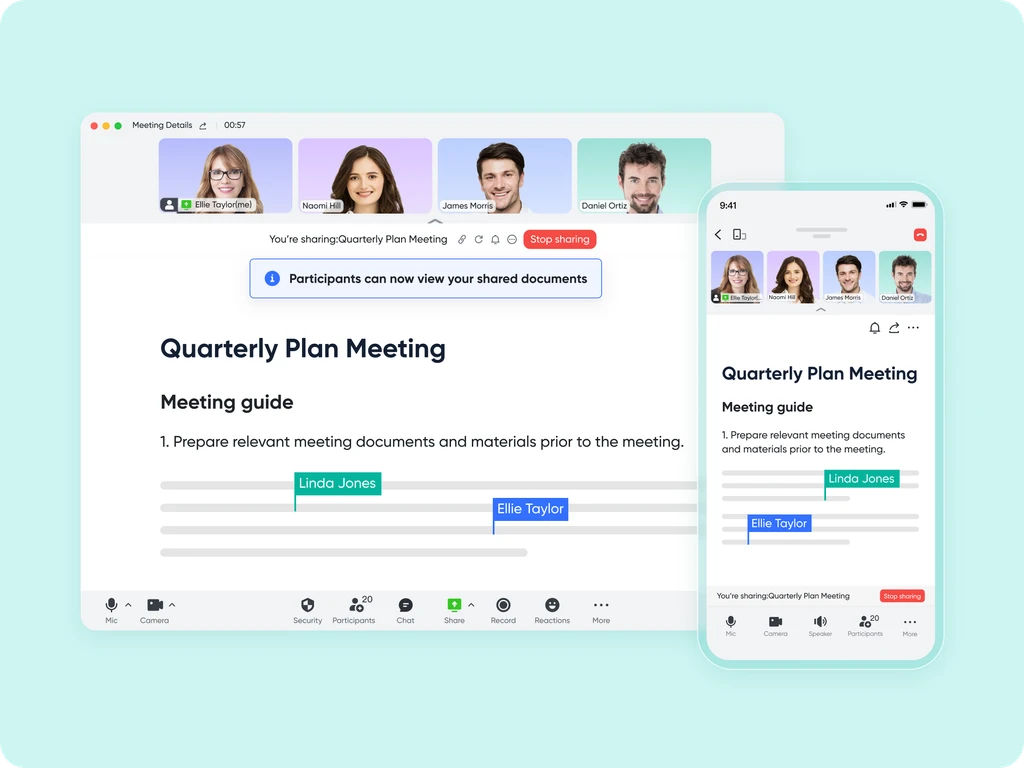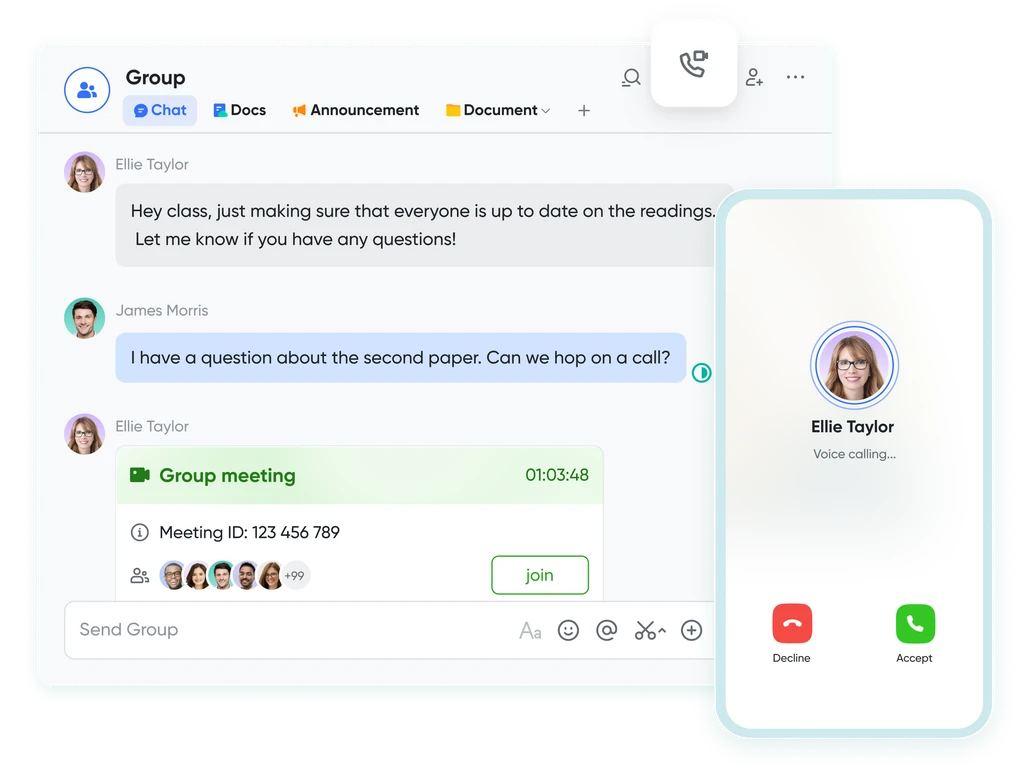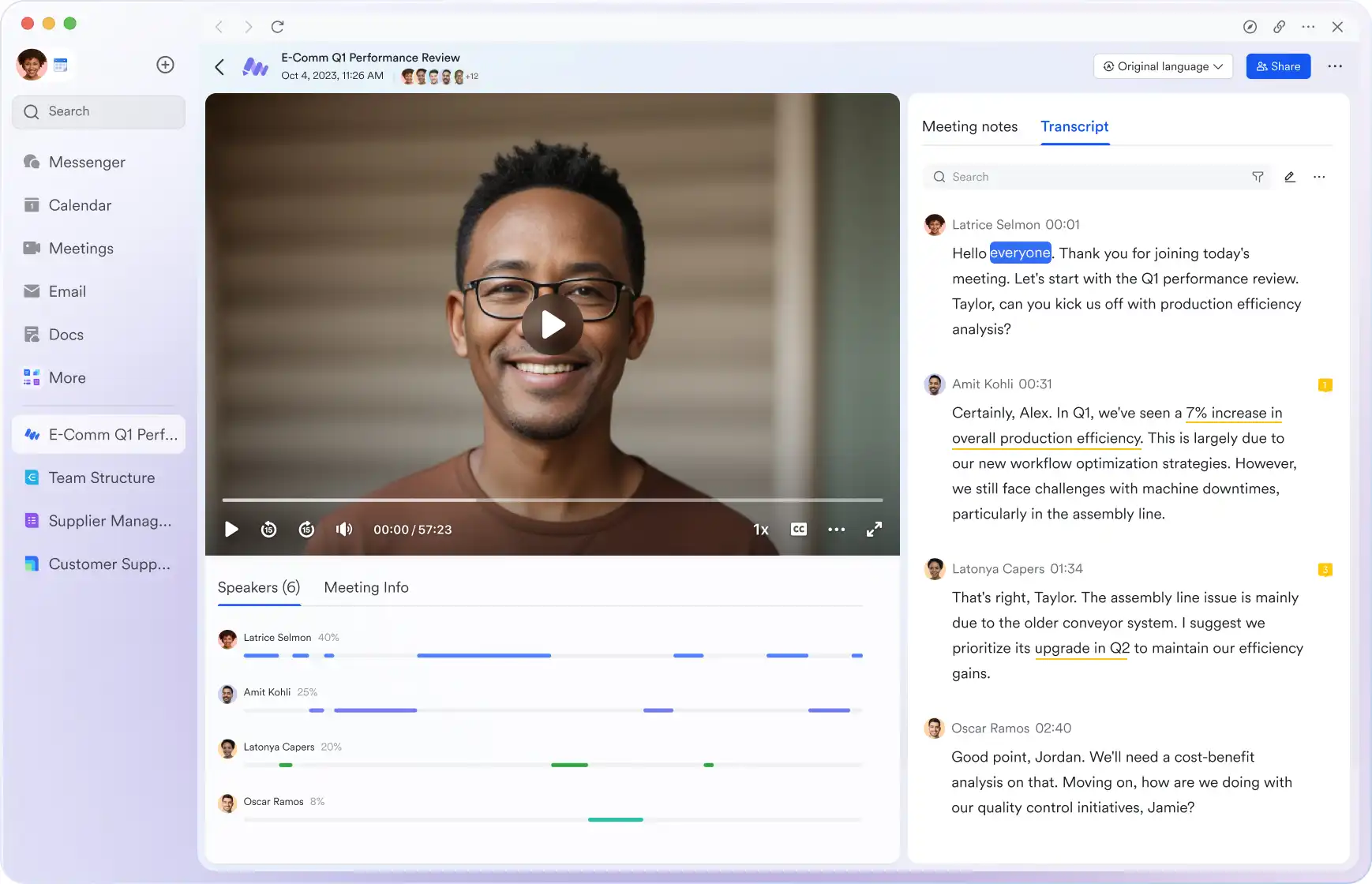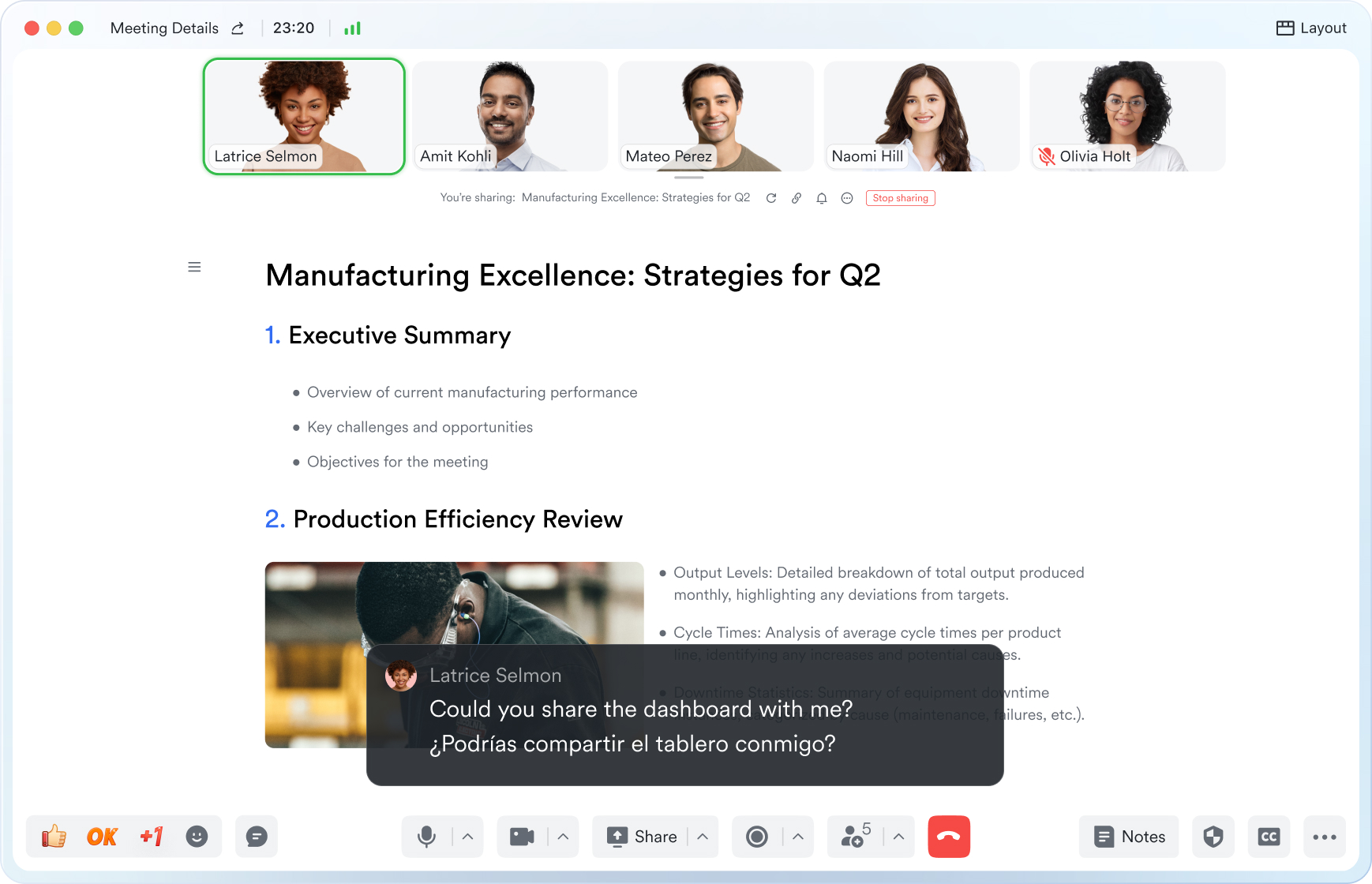Goal Setting Meeting
This guide will walk you through the essential elements of use goal setting meeting to keep your attendees aligned and engaged.
Try Lark for Free
As organizations navigate the ever-evolving landscape of the business world, the significance of goal-setting meetings becomes increasingly pronounced. These sessions, designed to align teams and individuals with organizational objectives, serve as pivotal platforms for setting targets, identifying challenges, and fostering collaboration. In this comprehensive guide, we will explore the nuances of running successful goal-setting meetings in 2024, offering actionable insights, best practices, and practical examples to elevate the productivity and impact of these essential gatherings.
Use Lark Meetings to turn meetings into true collaborative experiences.
What is a goal-setting meeting?
A goal-setting meeting serves as a dedicated forum for individuals and teams to outline their objectives, define strategies to achieve them, and establish accountability for their progress. These sessions are characterized by their focus on setting clear, measurable targets and fostering alignment across various levels of an organization. By engaging in open discussions, participants can collectively shape their approach to goal setting and address potential roadblocks, thus laying a strong foundation for future success.
Goals of a goal-setting meeting
The primary goals of a goal-setting meeting revolve around fostering clarity, alignment, and commitment to shared objectives. By the end of the meeting, participants should have a clear understanding of their individual or collective targets, a well-defined plan of action, and a sense of ownership and accountability towards their goals. Additionally, these meetings aim to cultivate a culture of collaboration and mutual support, emphasizing the collective pursuit of success.
Who should attend a goal-setting meeting?
Inclusive participation is vital for the efficacy of a goal-setting meeting. While the specific attendees may vary depending on the nature of the goals being addressed, it is essential to involve not only direct stakeholders but also individuals who can contribute diverse perspectives and insights. This may include team members, supervisors, department heads, and even relevant support personnel, all of whom can offer valuable input and alignment with the broader organizational vision.
Related:
Unlock the Power of Webinars: A Comprehensive Guide to Boost Your Business | Lark Blog | Lark BlogLearn more about Lark x Meetings
Topics, agenda, and structure of a goal-setting meeting
A well-structured agenda serves as the backbone of a productive goal-setting meeting. The agenda should encompass key topics such as goal review, progress assessment, identification of challenges, action planning, and the allocation of responsibilities. Additionally, the meeting structure should allow for ample discussion and interaction, ensuring that all voices are heard, and objectives are thoroughly explored and documented.
Related:
Master the Art of Meeting Notes with Lark for Enhanced Collaboration | Lark Blog | Lark BlogLearn more about Lark x Meetings
Frequency of goal-setting meetings
The frequency of goal-setting meetings may vary based on the nature of the goals, the pace of organizational activities, and the need for realignment. Generally, these meetings can occur quarterly, annually, or in alignment with specific project cycles. The goal is to strike the right balance, ensuring that the frequency is conducive to meaningful progress and adaptation as required.
Key differences between goal-setting meetings and similar gatherings
While goal-setting meetings may share similarities with other organizational gatherings, they are distinctly characterized by their focus on setting and reviewing objectives, establishing action plans, and fostering accountability. Unlike general team meetings or brainstorming sessions, goal-setting meetings are specifically geared towards driving clarity and commitment towards defined targets.
Learn more about Lark x Meetings
Three practical examples of goal-setting meetings
Empowering teams for quarterly progress
Empowering teams for quarterly progress
In a large marketing firm, quarterly goal-setting meetings are instrumental in aligning various teams and departments towards shared marketing objectives. Through these sessions, teams come together to review their progress, set new targets, and inspire each other through cross-department collaboration.
Individual development planning in a corporate setting
Individual development planning in a corporate setting
Within a corporate landscape, individual career development is crucial. Individual goal-setting meetings provide employees with the opportunity to align their personal growth plans with organizational objectives and receive feedback and support to drive their progress effectively.
Bridging organizational objectives and departmental goals
Bridging organizational objectives and departmental goals
In many organizations, connecting overarching company objectives with departmental goals is strategic. Goal-setting meetings facilitate this alignment, enabling departments to streamline their efforts towards collective success.
Common pitfalls of a goal-setting meeting
Despite their significance, goal-setting meetings may encounter several challenges that can impede their effectiveness. Some common pitfalls include:
- Lack of Clarity: Vague or ambiguous goals can hinder progress and impact accountability.
- Limited Engagement: Without active participation, the meeting may fail to generate actionable outcomes.
- Ineffective Follow-Up: Without a structured follow-up process, the actions identified in the meeting may remain unaddressed.
Learn more about Lark x Meetings
Dos and don'ts of a goal-setting meeting
| Do | Don't |
|---|---|
| Set clear and measurable goals | Overlook individual contributions |
| Foster open communication and feedback | Rely solely on top-down directives |
| Encourage collaborative goal setting | Neglect to follow up post-meeting |
Virtual success: navigating effective virtual goal-setting meetings
As remote work and virtual interactions become increasingly prevalent, it is essential to adapt traditional goal-setting meetings to the virtual environment. Leveraging technology and implementing engaging virtual meeting techniques can enable the seamless execution of these sessions, fostering active participation and meaningful collaboration.
Learn more about Lark x Meetings
Typical takeaways of a goal-setting meeting
Successful goal-setting meetings yield several critical takeaways, including clear goal alignment, actionable plans, enhanced collaboration, and a sense of collective ownership and accountability. Participants leave these meetings with a renewed focus on their objectives and a heightened motivation to achieve shared goals.
Questions to ask in a goal-setting meeting
The questions posed in a goal-setting meeting are integral to shaping meaningful discussions and driving actionable outcomes. Some key questions to consider include:
- What are the critical goals or objectives we aim to achieve?
- What challenges or barriers might hinder our progress towards these goals?
- How can we leverage individual strengths to bolster our collective efforts?
- What resources or support do we need to effectively pursue these goals?
- How will we measure and track our progress towards these targets?
Learn more about Lark x Meetings
Conclusion
In conclusion, goal-setting meetings in 2024 are poised to play a pivotal role in driving organizational success and individual growth. By embracing the best practices outlined in this guide, organizations can navigate the complexities of the evolving business landscape with confidence, leveraging these structured sessions as catalysts for progress, collaboration, and achievement.
Use Lark Meetings to turn meetings into true collaborative experiences.
A Game Changer for Goal Setting Meeting: Empower your team with Lark Meetings
In the fast-paced and dynamic world of modern business, effective communication and collaboration are crucial for success of Goal Setting Meeting. Here we introduce Lark Meetings to serve as a centralized hub for all communication needs.
Transform your meetings into collaborative endeavors

Leverage the potency of in-call document sharing, intelligent meeting minutes, and mobile-optimized features to enhance productivity collaboratively, irrespective of your location or schedule.
Seamlessly collaborate in real-time, across any device

Share live documents instead of just screen views. Participants can navigate and edit simultaneously within the video call window, even while on the move.
Shift your focus to engagement, not note-taking

Lark Minutes automatically converts video meetings into transcripts, facilitating easy viewing, searching, and collaborative editing. Stay in the loop asynchronously, even if you can't attend the live meeting. Lark Minutes for meeting minutes support translation into 10+ different languages.
Break language barriers in communication

Lark Meetings provide real-time translation for subtitles, allowing individuals from diverse backgrounds to express themselves in their native languages. Ensure every voice is heard, regardless of geographical location. Live subtitles currently support translations from English, Chinese, and Japanese to 10+ different languages. See more translation feature in Lark.
Connect with larger audiences
Host dynamic online meetings and events accommodating up to 1,000 participants, with the flexibility of up to 50 breakout sessions for intimate group discussions within the larger meeting context. Try more Lark features for free.








